Introduction
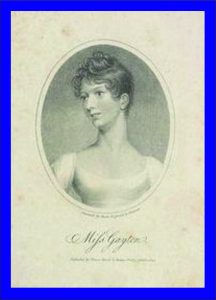 Esther Gayton is my original inspiration for the Unsung Histories website.
Esther Gayton is my original inspiration for the Unsung Histories website.
I still find it hard to believe that this woman’s story is not already “out there” somewhere, as in her time, she was actually quite well-known, albeit for a brief period. Even on family history websites, Esther Gayton’s descendants seem not to know of her years as a teenage dancing star. I am not aware of anyone else researching her life and performances so here we go with her story in full.
It was a tune, Miss Gayton’s Hornpipe which first set me off on her trail. A random post on Facebook had got me looking again at a set of tunes on an album first issued in the 1970s. However, these were not live recordings of an actual musician, but recordings from a barrel-organ which had been made in the very early nineteenth century and restored to playing condition in 1972, resulting in an LP on the Saydisc label. What was quite extraordinary was that this barrel organ had been on board a ship which sailed to the Arctic under the leadership of William Edward Parry, searching for a north west passage from the Atlantic to the Pacific. (See A Barrel Organ in the Arctic for the full story.) The music on the barrels comprised mainly social dance tunes popular in the period, but the album compilers had not been able to identify them all at the time, and so I asked on FB for help from musical friends who might recognise these tunes, many of which are still played in the folk music repertoire. One of the previously unnamed tunes turned out to be Miss Gayton’s Hornpipe, and as I was also aware of a stepdance routine by the same name, I did wonder who Miss Gayton was, and whether the crew on Parry’s ships had danced this same dance, or whether it was a social dance, as most of the other tunes on the barrel-organ were of this type.
As in so many of these explorations, there remain unanswered questions, but I was able to find out a huge amount about Miss Esther Gayton herself, who turned out to be not only – as I had suspected – a society lady – but actually a famous dancer on the stage for a brief period. She may have been much better known today if she hadn’t left the stage to marry a besotted clergyman twenty years her senior when she was only seventeen!
This page is Part One, which explores who she was, her personal life and stage performances from 1803-1809.
Esther Gayton part 2: ‘Miss Gayton’s Hornpipe’ looks at the tune and social dance together, and explores the links with the stepdance routine.
I normally put the thanks at the end of the article, but there is one person who has been absolutely central to this research, and that is dancer Simon Harmer, who has been equally as intrigued by this story as I, and who explored and reinterpreted the stepdance routine as a special project in 2020 (see part 2)
Esther Gayton: her life
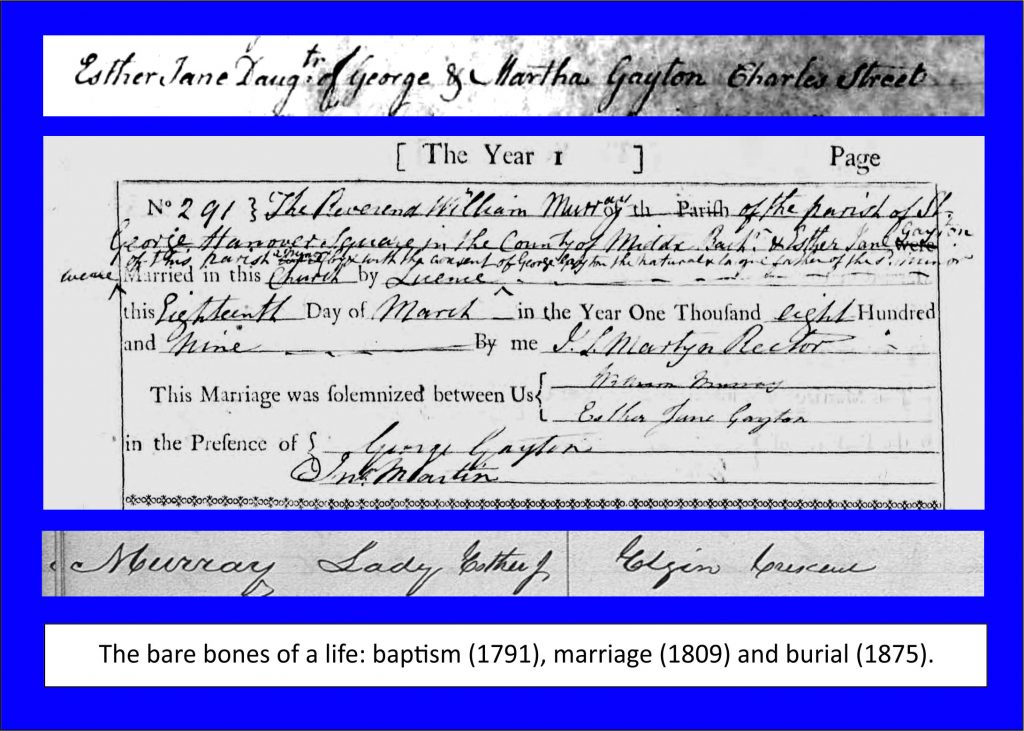
Esther was the eldest daughter of George and Martha Gayton. She was baptised in St Andrew’s, Holborn, London on 30th May 1791, and if we are to presume that her parents arranged the ceremony within a few weeks of her birth, as they did with their other children, we can surmise that she was born in early spring that year. By 1795 the family was in Islington, where all of Esther’s younger siblings were baptised, in St James. Islington at that time was quite a rural settlement on the fringes of London. We know from a newspaper report on Esther’s marriage in March 1809 that George was a hairdresser, a job which involved maintaining wigs and the high bouffant hairstyles of the period. Ordinary people did not use a hairdresser as a matter of course.
She seems to be the only member of her family to have taken to the stage, and appeared at Sadler’s Wells for the first time aged twelve or thirteen. In that period, children of much younger ages were often featured doing specialist dances, which may be why the newspaper announcement of her first appearance put her age as nine (see next section on her stage appearances).
Nothing is known about what her life was like as a young girl performing several times a week in the most prestigious London theatres, but dancing and acting were careers fraught with the potential for stepping outside the moral boundaries of the time. Esther’s behaviour seems to have been impeccable, and her one known suitor, William Murray, who became her husband, was clearly besotted with her, as comments in the press make clear. This man was over twenty years her senior, a clergyman with a living in Yorkshire, but who spent most of his time in London. William was the third son of a Scottish Baronet, and at the time of their marriage, was reputed to have an income of £2000 per year, so he clearly represented a stable future for Esther, who was in a notoriously fickle career herself. She was a minor at the time of her wedding in March 1809, but her father was a witness at the ceremony, so she had the support of her family, which is more than can be said for her groom. The marriage was described as “a mighty foolish business” by William’s brother, Sir James Pulteney Murray writing to Sir Charles Hastings on 30th May 1809, “but being, as you say, done, it is useless to think more about it.”
In 1812, William set up Esther’s father George (the hairdresser) in a completely different business: managing and driving a stagecoach. This was an area in which George clearly lacked practical expertise, although experienced at trying to give customer satisfaction. After leaving the carriage unattended in order to assist a lady passenger, the horses bolted, causing an injury to one of the passengers and he was charged with negligence. The Kentish Weekly Journal commented: “This was an action brought by a Bricklayer, against the father of Miss Gayton, late of the Opera Ballet, and now the wife of the Rev. Mr. Murray, who when he took the daughter off the stage placed the father upon it, establishing him in business as the proprietor driver of an Edmonton stage coach, running four horses …”
In 1813, William and Esther’s first child was born, James Pulteney Murray, baptised in Daventry in Northamptonshire. There followed five more sons and three daughters, all baptised in London. Tracing where the family lived has been very difficult, but one tragic incident which took place on New Year’s Eve 1821 reveals that they were living at quite a superior address: 22 Charles Street, off Berkeley Square, a house later lived in by the Duke of Clarence. The horrific incident must have scarred the survivors for life, as their son James, aged eight, managed to accidentally shoot dead Esther’s 16 year-old sister Mary with a pistol belonging to William. It is not hard to imagine the recriminations that probably took place between husband and wife over this tragedy.
Their youngest child, Esther Jane, was born in 1825, when Esther herself was 35. In those days it was normal for women of all classes to carry on bearing children until the menopause, unless a medical condition or marital problem intervened. The possibility of a breakdown in Esther’s marriage is supported by other (albeit sparse) evidence. I would expect to be able to trace Esther through the censuses from 1841 onwards, but she has proved extraordinarily elusive and in 1841, William and most of the children are found in Cadogan Place in Kensington, but there is no trace anywhere of Esther. William died in 1842 and his will, drawn up on 23rd July 1827, contains not a single mention of Esther. Coincidentally (or not) on the same day, Esther’s name appeared in a paragraph in the Stamford Mercury exonerating the behaviour of another actress and including her amongst those actresses living a respectable life.
After the death of his older brother John in 1827, William became the 9th Baronet of Clermont/Dunerne (the title seems to vary in different sources).
In 1851 I believe we may have now identified an Esther Murray – aged 60, visitor in a boarding house in Marylebone, but described as born in Scotland – as “our” Esther. The woman on the line above her is also the widow of a clergyman and the whole establishment is clearly very well-to-do. I have drawn a complete blank on the 1861 census, but have definitely found her in 1871, living on Elgin Crescent in Notting Hill, at the same address where she died on 6th February 1875. The circumstances are again a bit strange, in 1871 she was a “visitor” with Jane Nicoll, the daughter of a clergyman, who from at least 1861 took in boarders. Jane passed away a year before Esther, but the doctor who signed Esther’s death certificate was her brother. It looks as if she was relying on the charity of other clergy families rather than her own children. Quite what income she had if William had cut her out of his will is not known; presumably her children, who inherited William’s title, money and estates, must have provided for her financially.
So a life that started in relative obscurity – albeit fairly comfortable and respectable – seems to have finished in the same way, but what happened inbetween was certainly not obscure, featuring in a number of newspapers and periodicals.
Esther Gayton: her dancing career
During Esther’s brief career on the stage, the London theatres were still severely restricted by the Licensing Act of 1737, so that only the two Theatre Royals (in Drury Lane and Covent Garden) could produce actual plays with spoken dialogue, and the other non-patented theatres had to work round these constraints by putting on a mixture of dance, mime, song and novelty acts to attract their audiences. Programmes would change every few days, and new items were often changed and reworked to tight schedules. Esther’s first public performance was in 1803, at Sadler’s Wells, in Islington, where she lived.
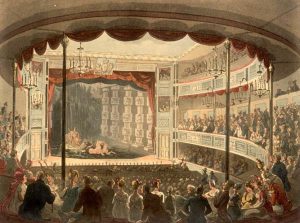 The Sadler’s Wells website says: “By 1801 [ … ] Sadler’s Wells had become more famous for incidents, both devised (spectacular sea battles) and accidental (a terrible stampede in which 18 people died) than for work of merit.” The 1810 picture on the left shows a real waterfall on stage.
The Sadler’s Wells website says: “By 1801 [ … ] Sadler’s Wells had become more famous for incidents, both devised (spectacular sea battles) and accidental (a terrible stampede in which 18 people died) than for work of merit.” The 1810 picture on the left shows a real waterfall on stage.
It was taken over by Charles Dibdin junior late in 1802, and early in his tenure, Esther was a named performer (“her first performance in public”), performing a “Hornpipe, with a Skipping Rope” in an advertisement from 9th April 1803. She was described as a “pupil of Mr Jackson, late of Covent Garden Theatre, only 9 years of age”, although in fact she was twelve. The advertisement is for the opening of the new season, under new proprietorship and totally refurbished, and as such, spares no detail in trying to attract the London gentry to make the journey to Sadler’s Wells: “the private boxes in the lower part of the theatre have been totally altered from last season, and are now perfectly calculated to accommodate the nobility, gentry, and families in the most eligible manner; and for the convenience of the public, the proprietors have put on additional patrols in the field leading from the Wells to town, also a quantity of additional lamps in the said field, and in the avenues to the theatre.”
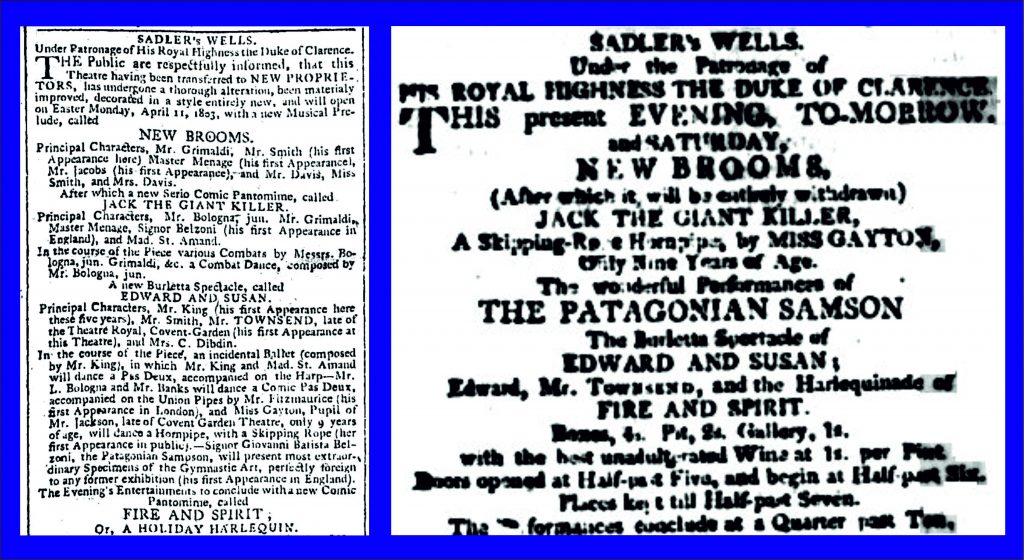
In June 1803 Esther had further roles at Sadler’s Wells, in dance pieces including Hey for the Highlands; or Jemmy’s Return and Ko and Zoa, the latter a composition by Charles Dibdin junior.
In October 1804 she performed in a benefit night at the Opera House, which included “the favourite Skipping Rope Hornpipe”, and the newspaper announcement for this event stated that she was now a pupil to Mr Gouriet. Dennis Francois Victor Gouriet was another high profile ballet master, born in Paris, who composed dances for Sadler’s Wells and also danced at the King’s Theatre under James Harvey D’Egville, who was Esther’s next mentor, from at least 1806.
D’Egville was the ballet master at Drury Lane and had started his choreography career at the King’s Theatre in 1793. Esther was evidently one of his star pupils, being picked out for special mention on several occasions, such as a benefit night for D’Egville at Drury Lane on 14th May 1806:
“The Public are most respectfully informed, the Ballets performed on this Evening are by Permission of the Proprietors of the King’s Theatre, and positively for this night only. For the BENEFIT of MR D’EGVILLE. This Evening their Majesties Servants will act the WEST INDIAN. At the end of Act 1 (by particular desire of several Persons of Distinction, the much admired ballet of PAUL and VIRGINIA. Arranged by Mr D’Egville for his pupils, and performed with universal applause at the King’s Theatre by Miss Gayton and the rest of Mr D’Egville’s Young Pupils. At the end of the play, the favourite Grand Ballet of CRAZY JANE. The part of Crazy Jane by Mad[ame]. Laborie. In the course of the ballet, the Minuet de la Cours and the Gavotte, by Mr D’Egville and Miss Gayton; and several new Dances by his Pupils. To which will be added. YOUTH, LOVE and FOLLY.”
D’Egville (1770-1836) is sometimes credited with being the most influential ballet master after John Weaver (1673-1760). During the Napoleonic wars the need was felt to train more English dancers, and he founded an academy of dance to do just that, although interest in developing English talent waned after 1815. The critic Henry Robertson was evidently not persuaded of this approach and wrote the following about D’Egville’s 1808 production of Le Mariage Secret; ou, les Habitants du Chene:
“In this ballet as well as every other production of Mr. D’Egville, the audience are annoyed with the perpetual introduction of his pupils, who are continually flitting before the eyes, and labouring by roughed faces, ghastly grins, and languishing attitudes, to compel admiration, while they only excite disgust or pity.”
Whatever the critics thought, the newspapers were unmitigated in their praise for Esther Gayton and D’Egville’s other pupils over the next couple of years. Esther was indeed fortunate –and clearly talented enough – to be taken on by such an influential teacher, and her first leading part came in February 1807, as the eponymous Emily; or Juvenile Indiscretion, in a dance composed by D’Egville. Newspaper reports from the time give a good flavour of how dance pieces fitted into the overall programme, and how they could be changed at short notice if they didn’t meet with the audience’s approval.
In 1808, Esther hit the big time. James D’Egville was appointed acting manager of the entire company as well as principal dancer and ballet master, and newspapers across the country announced his engagement at the Opera (i.e. Theatre Royal). Details of the main performers’ salaries are given: Esther’s is quoted as £150 per year, which is amongst the lower amounts, and certainly nothing like the thousands of pounds demanded by the star singers such as Angelica Catalani or even the £800 paid to D’Egville. Her appointment came with the retirement of Rose Parisot (pictured below, right) and although Esther wasn’t initially seen as the star of the new cohort, she actually attracted much of the attention, and performed Parisot’s famous shawl routine to critical acclaim: “Miss Gayton, pupil to the new Manager, succeeded Madame Parisot, and in the ShawI Dance in particular displayed so much elegance and grace, as to render her every way worthy of the situation she has been thus brought to fill. She is a native of England, and affords a gratifying proof that the talents we have hitherto sought in France, may be supplied at home. It indeed evidently requires only a discerning Master, capable (as Mr. D’Egville has proved himself) of making a judicious choice of the objects of his instructions, to render the Ballet Department wholly independent of foreign aid.”
The journalist for the Morning Post, where the above comment appeared on 4th January 1808, was clearly a big fan of Esther, as just a couple of weeks later he also wrote: “The ballet of La Belle Laitière succeeded, and we saw with increased pleasure the elegant performance of D’EGVILLE’s little pupil, Miss GAYTON, whose dancing is perhaps more graceful than that of any English actress that has appeared on the Italian stage.”
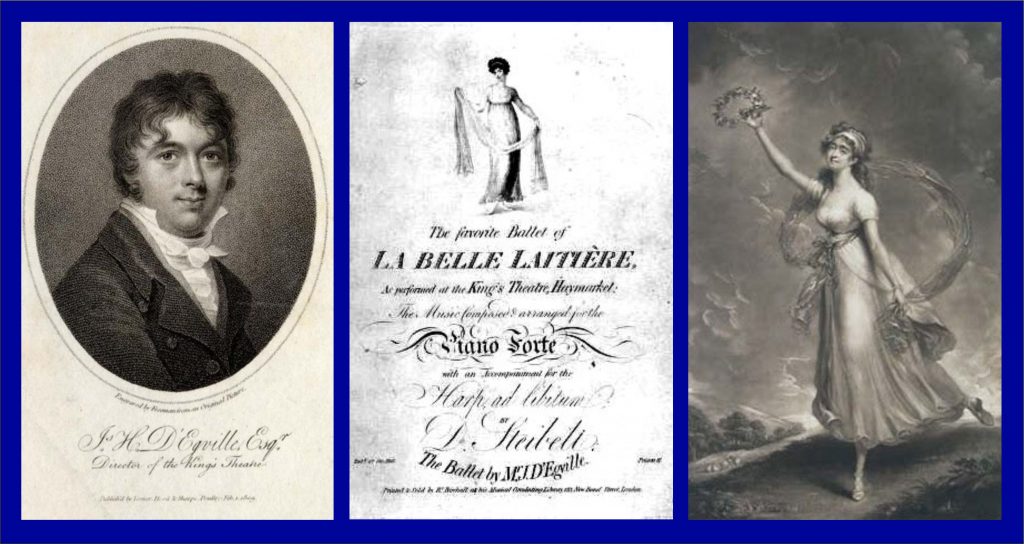
The Morning Chronicle in March noted once again the skills of her hornpipe dancing: “King’s Theatre – a new Pastoral Ballet was brought out on Saturday night, by Mr D’EGVILLE which has some pretty music, and in which the light and elegant Miss GAYTON danced a hornpipe with great éclat.”
By the summer, she was quite a fixture on the stage, and on 28th September had the honour of performing for many members of the royal family (including Queen Charlotte) at the Countess of Cardigan’s house, in fashionable and aristocratic Richmond Hill, overlooking the Thames: “MISS GAYTON from the Opera, exhibited her elegance and naiveté with the happiest effect. After her sprightly hornpipe, she was particularly called on for her shawl dance, which she performed to general admiration…”.
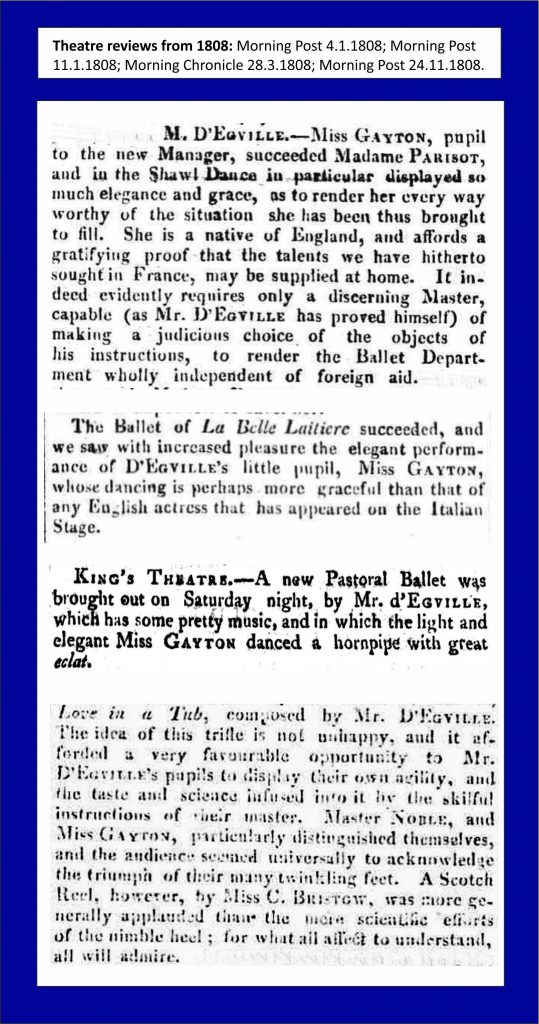
Later in the year she performed in two pieces for which she became widely known: Caractacus, in which she had the role of Isla and “the grand Romance Bluebeard; or Female Curiosity” which was revived at Drury Lane with a new dance composed by D’Egville.
It is the latter performance which is said to have inspired this couplet by Lord Byron, in a long poem called English Bards and Scotch Reviewers, written in 1808:
“While Gayton bounds before th’ enraptured looks
Of hoary marquises and stripling dukes;”
Below is Henry Bishop’s original score for Miss Gayton’s Pas Seul in Caractacus, and an arrangement retailed for amateur pianists.
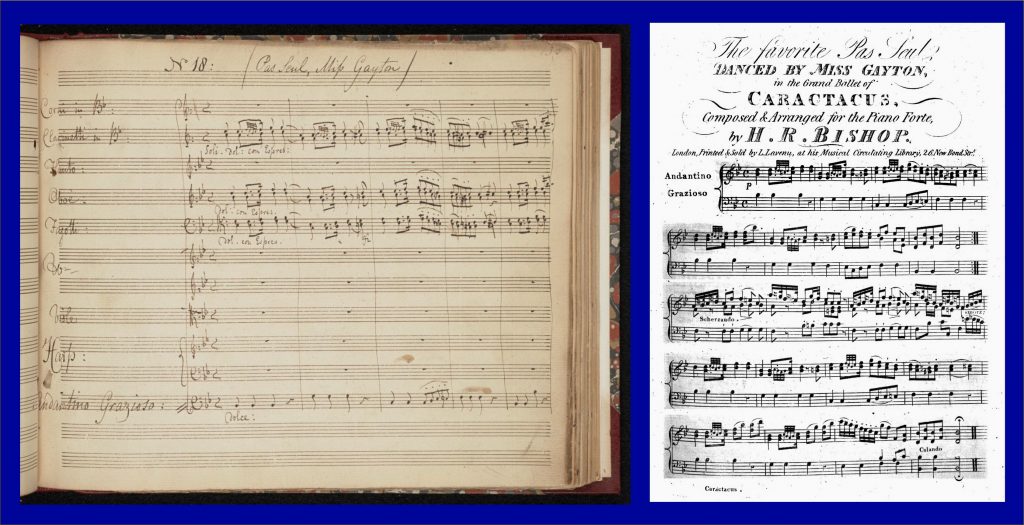
1809 began on a very positive note, as the Sun noted on 7th January that “DESHAYES, MOREAU and MISS GAYTON retain their situations, so the Corps de Ballet will be very effective this season.” and Esther took on a leading role in Les Amours de Clauque. However, on 24th February Drury Lane burned down and the theatre world was thrown into disarray, as a dispute between the owners and performers ensued.
A shock of another sort was to come in March of course, and as a minor stage celebrity, Esther’s forthcoming nuptials attracted some press comment:
“Young Miss Gayton quits the stage next week, and is to be married to a well-beneficed clergyman who has been her constant admirer at the opera.” (Morning Chronicle, 9.3.1809)
“The fascinating GAYTON danced for the last time. She is to be led to the hymenial altar by the REV MR. MURRAY.” (Morning Chronicle, 13.3.1809)
The Monthly Mirror carried a portrait of Miss Gayton and some “memoirs” of her and James D’Egville in its March edition:
“She is now about sixteen years of age [she was 18] and on the eve of being married to the REV Mr. MURRAY, aged forty-four [he was 40], when she will cease to “caper nimbly,” much to the sorrow of Mr D’Egville, whose pupil she is, and who will feel on the occasion just as Dr. Pangloss feels when he finds that the honourable Mr. Dowlass is about to celebrate his nuptials, and to discard his expensive ‘bear leader’ for ever.”
The writer refers here to two characters in George Colman’s 1800 drama The Heir-at-Law; the phrase “bear leader” initially meant exactly that – a man leading a performing bear – but was also used colloquially for a man who accompanied wealthy young men on their travels.
The gossip writers clearly picked up some issue over the wedding, which was delayed for a week, as even eighteen months later, in December 1810, the Morning Post felt the need to declare that the marriage had actually taken place.
So Esther’s stage career ended just as her star was in the ascendant. Some women dancers did continue their careers after marriage, but the expected pattern of frequent childbearing in those days did not, of course, work in their favour, so many did retire on marrying.
She was clearly seen as a dancer of great promise, and was particularly favoured as being an English dancer at a time when many of the stars were from mainland Europe.
For a fuller biography of Esther Gayton’s life, you can read this PDF: Miss Gayton’s Biography or to read more about her stage performances: Miss Gayton’s stage performances. If you’d like to use this information in any way, please remember to acknowledge this website as your source.
The second part of this article is Esther Gayton part 2: ‘Miss Gayton’s Hornpipe’ .
See also A Barrel Organ in the Arctic and Will the Real Paddy O’Rafferty please stand up!
A huge number of people have helped discuss various aspects of this research, my thanks to them all, especially for this first article: Dick “Dr Watson” Mathews for his genealogical insights and investigations and Keith Cavers for reading the section on the stage and ballet history.
Further Information
For information about the theatre and ballet in late Georgian times, and the London stage, there are some good sources online as well as the more specialist books I have consulted.
The British Library has good introductory pages on the London stage in the 18th century and the 19th century and the Sadler’s Wells website is also excellent, and the source of the 1810 image.
Sources referred to in the article:
The quote from James Murray about his brother William’s marriage to Esther Gayton is from Letters from America, 1773 to 1780 : being the letters of a Scots officer, Sir James Murray, to his home during the War of American Independence, edited by Eric Robson, 1950.
The quote about D’Egville’s pupils is from Ballet in Early Nineteenth-Century London as Seen by Leigh Hunt and Henry Robertson, by Theodore Fenner (Dance Chronicle Vol. 1, No. 2, 1977 – 1978)
The review of Tekeli or The Siege of Montgatz is from La Belle Assemblée 1806-1807, which can be found on Google Books.
Henry Bishop’s original score for Caractacus – including whole pages crossed through as the piece was deemed too long after its initial showing finished at 1am! – may be perused online in the Library of Congress’s digital archive. The piano arrangement for Miss Gayton’s Pas Seul is also on Google Books.
Newspaper reports:
- Miss Gayton’s first appearance in public at Sadler’s Wells – The Sun, 9th April 1803
- Mr D’Egville’s benefit night at Drury Lane – Morning Post, 14th May 1806
- Advertisement for Miss Gayton’s Dance in Tekeli – Morning Chronicle, 11th August 1807
- Esther dancing the Parisot shawl routine – Morning Chronicle, 4th January 1808
- Esther dancing for the Royal family – Morning Post, 30th September 1808
- Esther Gayton’s father’s episode as a stagecoach driver – Kentish Weekly Post or Canterbury Journal, 7th July 1812.
I was particularly interested in the reference to Esther dancing for the Royal family at the Countess of Cardigan’s house in Richmond. I grew up near there and a regular Sunday afternoon outing was with my grandparents to the Terrace Gardens, along the banks of the Thames. Little did I know that the thatched summerhouse and spooky, cold, ice-house that I loved to clamber around as a five year-old had stood in the grounds of that house where Esther enchanted the Royal Family with her trademark hornpipe dance! Information on Cardigan House and the Terrace Gardens gleaned from the Historic England listing.
Please note: Anyone wishing to cite this original research should credit it to Katie Howson and cite this website as the source.
I have unearthed far more material on Esther Gayton’s performances and personal life, the tune, and the dance, than can be written up here. Please do get in contact if this is a special area of interest or study to you, I would be happy to tell you more.
Leave a Reply